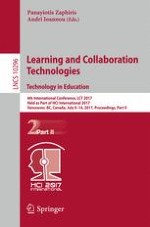
2017 | OriginalPaper | Chapter
Using Augmented Reality Interactive System to Support Digital Electronics Learning
Authors : Poonpong Boonbrahm, Charlee Kaewrat, Salin Boonbrahm
Published in: Learning and Collaboration Technologies. Technology in Education
Publisher: Springer International Publishing
Activate our intelligent search to find suitable subject content or patents.
Select sections of text to find matching patents with Artificial Intelligence. powered by
Select sections of text to find additional relevant content using AI-assisted search. powered by